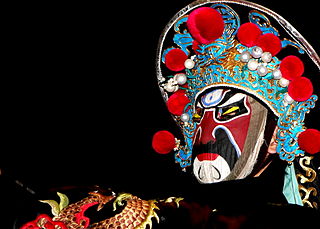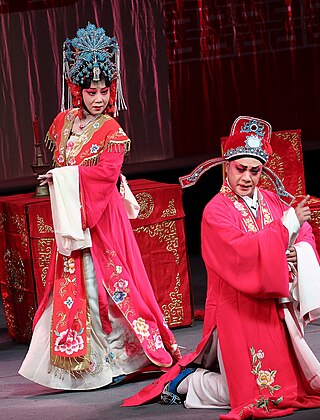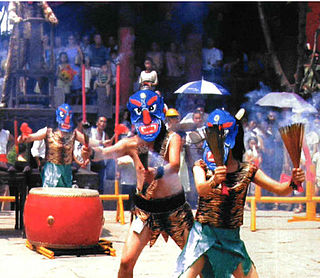
Traditional Chinese opera, or Xiqu, is a form of musical theatre in China with roots going back to the early periods in China. It is an amalgamation of various art forms that existed in ancient China, and evolved gradually over more than a thousand years, reaching its mature form in the 13th century, during the Song dynasty. Early forms of Chinese theater are simple; however, over time, various art forms such as music, song and dance, martial arts, acrobatics, costume and make-up art, as well as literary art forms were incorporated to form traditional Chinese opera. Performers had to practice for many years to gain an understanding of the roles. Exaggerated features and colors made it easier for the audience to identify the roles portrayed.

Kunqu, also known as Kunju (崑劇), K'un-ch'ü, Kun opera or Kunqu Opera, is one of the oldest extant forms of Chinese opera. It evolved from a music style local to Kunshan, part of the Wu cultural area, and later came to dominate Chinese theater from the 16th to the 18th centuries. It has been listed as one of the Masterpieces of the Oral and Intangible Heritage of Humanity by UNESCO. Wei Liangfu refined the musical style of kunqu, and it gained widespread popularity when Liang Chenyu used the style in his drama Huansha ji. In 2006, it was listed on the first national intangible cultural heritage list. In 2008, it was included in the List of Representative Works of Intangible Cultural Heritage of Humanity. In December 2018, the General Office of the Ministry of Education announced that Peking University is the base for inheriting excellent traditional Chinese culture in Kunqu.
Shengqiang is a concept in Chinese opera which helps to categorize its hundreds of regional genres by the music played during arias. Classifying by the music, as opposed to the regional dialect, also helps to understand a genre's evolutionary history. For example, Peking opera and Cantonese opera have little in common as far as language or place of origin, but they belong to the same shengqiang system. Today, the four major shengqiang are Bangziqiang, Pihuangqiang, Kunqiang and Gaoqiang. Not all Chinese opera genres fall into one of these four shengqiang systems, and many genres can be classified into more than one system. Other shengqiang in history include Yuyaoqiang and Haiyanqiang.

Theatre of China has a long and complex history. Traditional Chinese theatre, generally in the form of Chinese opera, is musical in nature. Chinese theatre can trace its origin back a few millennia to ancient China, but the Chinese opera started to develop in the 12th century. Western forms like the spoken drama, western-style opera, and ballet did not arrive in China until the 20th century.

Huangmei Opera or Huangmei tone is a form of Chinese opera originating from Anqing, Anhui province, as a form of rural folk song and dance. It is also referred to as Anhui Opera. It has been in existence for the last 200 years and possibly longer. Huangmei opera is one of the most famous and mainstream opera in China, and is a class of the typical Anhui opera. The original Huangmei opera was sung by women in Anqing areas when they were picking tea, and the opera was called the Picking Tea Song. In the late Qing dynasty, the songs were popular in Anhui Huaining County adjacent regions, combined with the local folk art, Anqing dialect with singing and chants, and gradually developed into a newborn's operas. The music is performed with a pitch that hits high and stays high for the duration of the song. It is unique in the sense that it does not sound like the typical rhythmic Chinese opera. In the 1960s Hong Kong counted the style as much as an opera as it was a music genre. Today it is more of a traditional performance art with efforts of revival in mainland China, Hong Kong, and Taiwan, and mostly sung in Mandarin. In 2006, Huangmei Opera was selected for the first batch of China's national intangible cultural heritage.

Ningguo is a county-level city in the southeast of Anhui province, People's Republic of China, under the administration of Xuancheng City and bordering Zhejiang province to the south and east. It has a population of 380,000 and an area of 2,447 km2 (945 sq mi).

Sichuanese, also called Sichuanese Mandarin, is a branch of Southwestern Mandarin spoken mainly in Sichuan and Chongqing, which was part of Sichuan Province until 1997, and the adjacent regions of their neighboring provinces, such as Hubei, Guizhou, Yunnan, Hunan and Shaanxi. Although "Sichuanese" is often synonymous with the Chengdu-Chongqing dialect, there is still a great amount of diversity among the Sichuanese dialects, some of which are mutually unintelligible with each other. In addition, because Sichuanese is the lingua franca in Sichuan, Chongqing and part of Tibet, it is also used by many Tibetan, Yi, Qiang and other ethnic minority groups as a second language.

Bian Lian is an ancient Chinese dramatic art that is part of the more general Sichuan opera. Performers wear brightly colored costumes and move to quick, dramatic music. They also wear vividly colored masks, typically depicting well known characters from the opera, which they change from one face to another almost instantaneously with the swipe of a fan, a movement of the head, or wave of the hand.

Yu opera, or Yuju opera, sometimes known as Henan bangzi, is one of China's famous national opera forms, alongside Peking opera, Yue opera, Huangmei opera and Pingju. Henan province is the origin of Yu opera. Henan's one-character abbreviation is "豫" (yù), and thus the opera style was officially named "豫剧" (Yùjù) after the founding of the People's Republic of China. The area where Yu opera is most commonly performed is in the region surrounding the Yellow River and Huai River. According to statistical figures, Yu opera was the leading opera genre in terms of the number of performers and troupes. While Yu opera is often called "Henan opera" in English, within Henan it is considered to be just one of the province's three most important forms of opera, the other two being Quju (曲剧) and Yuediao (越调).

The flower-drum opera or Huaguxi is a form of Chinese opera originating in Hunan province. Some other provinces, such as Hubei, Anhui, Henan, Shanxi, also have Huaguxi. It is known in China for its earthy quality, and is often referred to as the "spicy" form of Chinese opera.

Nuo theatre, Nuo drama, Nuo opera, or Nuoxi is a traditional theatrical art popular in many regions of China. Characterized by its special features such as ferocious masks, unique dresses and adornments, the strange language used in performance, and mysterious scenes, Nuo theatre has been selected as one of the non-material cultural legacies of China. The opera is a religious performance intrinsic to the culture of Nuoism, a type of Chinese folk religion. The purpose of Nuo theatre is to drive away devils, disease and evil influences, and also to petition for blessings from the gods. Singing and dancing are included in Nuo theatre and performers wear costumes and masks.

Anhui Opera, also known as Huiju [徽剧], is a traditional Chinese opera form that originated in Anhui Province during the Ming Dynasty. It is a crucial part of Huizhou culture and significantly contributed to the development of Peking Opera.
Luju or Lu opera (Chinese: 庐剧; pinyin: Lú jù, formerly known as daoqixi, is a variety of Chinese opera from the east-central province of Anhui, China. Luju's name came from the former name of Hefei, Lu Zhou. In 2006, Luju was regarded as Intangible cultural heritage in China.

Ou opera, originally known as Wenzhou luantan or Yongjia luantan, is a regional form of Chinese opera from Yongjia County, Wenzhou in southeastern Zhejiang province. In addition to Wenzhou and parts of neighboring Lishui and Taizhou, it is also influential in parts of northern Fujian and northeastern Jiangxi.

Tongzi opera is a regional form of Chinese opera popular in the rural areas of Nantong in southeastern Jiangsu province and Lianyungang in northeastern Jiangsu province. It is traditionally sung in local dialect and accompanied by gong and drum. The form resulted from the blending of a local religious activity called shang tongzi with theatre.
The Jiangsu Performing Arts Group, or JPAG, is a theater company established in 2001 and based in Nanjing, Jiangsu, China. It is one of the largest performing arts groups in China and has won eighteen Plum Blossom Prizes and twenty-one Wen Hua Awards. It has also been named "National Key Enterprise for Cultural Export" six times. The group participates in the Chinese Cultural System Reformation.
Zhang Jiqing was a Kunqu artist.
Huaihai opera is a form of local traditional Chinese theatre which combines musics, vocal performance, and dance. Some plays contain mime, acrobatics, and Kung fu. It was created in the 19th century and fully developed in the World War II. The form is popular in Shuyang, Suqian, Lianyungang and Yancheng, with the dialect of Shuyang as the standard pronunciation.

Kung Pao chicken, also transcribed Gong Bao or Kung Po, is a spicy, stir-fried Chinese dish made with cubes of cooked chicken, peanuts, vegetables and chili peppers, and Sichuan peppercorns. From its origins in Sichuan cuisine, the dish's popularity has spread throughout China, spawning a number of regional variations—some of which are less spicy than the classic version.

Ba-Shu culture refers to a regional culture centered around Sichuan province and Chongqing city, also encompassing parts of Yunnan, Guizhou, southwestern Shaanxi and neighboring regions which speak Southwestern Mandarin. Historically centered around the Yangtze River, it emerged as an amalgamation of the cultures of the Shu and Ba kingdoms after their conquest by the state of Qin in 316 BC.

















